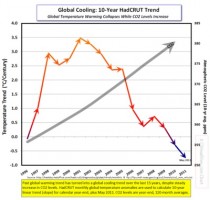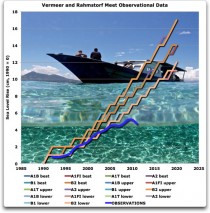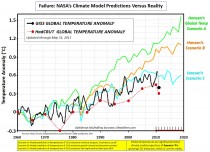C3 Headlines
Note: Just prior to this posting, it became public that a new Proceedings of the National Academy of Science (PNAS) study confirms that global warming has been missing since 1998. This new study refutes James Hansen, Al Gore and all the IPCC Climategate scientists claims of “unequivocal,” “unprecedented,” and “accelerating” global warming they have made over recent years. Global warming skeptics have proven to be correct, which the below material also supports.
In a previous post, we reviewed the last 15 years of HadCRUT temperature records, which show that global warming has become insignificant. In fact, one could accurately state that a global cooling trend is now replacing a global warming trend in an “unequivocal” and “accelerating” manner, using the greens’ own favored warming alarmist terms. (click to enlarge)

When examining the past 15 years of monthly global temperature anomalies, the per century change from a warming trend to a cooling trend becomes clear. Calculating 10-year linear trends from the monthly anomalies, the above chart plots end of year per century trends (plus the May 2011 10-year trend).
As can be seen, since 2001 the per century trends have conclusively switched from a global warming direction to a global cooling direction. In addition, the early 2011 temperature anomalies confirm what has actually been taking place since 2001. If the May 2011 10-year trend continues, the global temperature by 2100 will have decreased by -0.67C.
This warming to cooling reversal has happened in the face of “business as usual” increases in atmospheric CO2 levels. And this global temperature phenomenon reversal has occurred despite the “consensus” claims of IPCC “climate scientists” and predictions of the bureaucrats’ climate models. (The lower left chart clearly depicts how badly the climate models have failed.)
The lower right chart depicts a similar global cooling trend outcome over the last 15 years. Using the same monthly anomaly data, this chart’s per century trends are based on 5-year linear calculation.

Enlarged.
Regardless of how the temperature anomaly records are examined, the last 15-year span has seen the global warming trend fade as the world seemingly moves into a global cooling mode (the continental U.S. 15-year record of temperatures confirms this cooling trend). How long this will persist and how deep the cooling trend may become is pure speculation. And indeed, there is no concrete, emprically proven, scientific reason to assume the cooling will continue - the climate is complex and chaotic, which makes accurate predictions impossible.
These are the take home facts:
1. Global warming is neither unequivocal, accelerating, or even unprecedented.
2. Global cooling is becoming a trend but it’s not clear whether it’s accelerating and unequivocal.
3. Rapidly increasing atmospheric CO2 levels have not caused the requisite acceleration of global temperature increases.
4. CO2 levels appear to have little impact on global temperatures.
5. Global temperatures are in a deceleration mode, totally contrary to IPCC’s climate models.
6. Recent severe weather events (2010 and 2011) are not a result of increasing global temperatures; based on the actual temperature evidence since 2001, recent severe weather would more likely be a result of accelerating cooling.
7. Climate models have been stupendously wrong about global warming and climate change, time after time.
Additional modern temperature charts. Unequivocal fake warming, temperature fabrication charts.
Of couse, when your paradigm fails, they flail away and come up with some lame excuse as to why it failed. That came with a paper that claimed Chinese production of sulphate aerosols in their power plants was offsetting the warming ‘temporarily’. Of course, the ‘scientists’ used a computer model of the climate to show that natural fluctuations, such as variations in solar activity as measured by the record low in sunspots, cannot on their own explain the observation. See the nonsense here.
We knew this was coming. Predictably, Michael E Mann, at Pennsylvania State University, not part of the research team, said the study that warming was being masked by emissions from Chinese power plants was “a very solid, careful statistical analysis” which reinforces research showing “there is a clear impact of human activity on ongoing warming of our climate”. It demonstrated, Mann said, that “the claim that ‘global warming has stopped’ is simply false.” - The Guardian, 4 July 2011. Always an excuse for failure and Mann has a closet full.
“The political consequence of this article seems to be that the simplest solution to global warming is for the Chinese to burn more coal, which they intend to do anyway,” writes Judith Curry.
Curry from Georgia Institute of Technology, doesn’t find the economists’ statistical theatrics convincing. She wonders why the short-lived regional increases in particulates should have a global effect on temperatures. She also notes that there has been no increase in aerosols, either globally or over East Asia, from 2000 to 2006; Chinese emissions only rose in the period 2004 to 2007. Kaufmann et al do acknowledge that a La Nina weather pattern cooled the planet between 1998 and 2010. H/t Marc Morano.
The IPCC used the same aerosol excuse to explain the 1945 to 1977 cooling and support their greenhouse forcing argument.
Roger Pielke Sr. adds: One cannot use models to “show” anything. Real world observations must be paramount. Models are only hypotheses.
There is an informative article on this subject: Fildes, R. and N. Kourentzes, 2011: Validation and forecasting accuracy in models of climate change. International Journal of Forecasting. doi 10.1016/j.ijforecast.2011.03.008 which I posted here.
For example, they write
“...the structural weaknesses in the GCM identified here suggest that a reliance on the policy implications from the general circulation models, and in particular the primary emphasis on controlling global CO2 emissions, is misguided (a conclusion which others have reached by following a different line of argument, see Pielke Sr. et al., 2009).”
Guest Post by Willis Eschenbach on WUWT
Much has been made in AGW circles of the sea level forecast of Vermeer and Rahmstorf, in “Global sea level linked to global temperature” (V&R2009). Their estimate of forecast sea level rise was much larger than that of the IPCC Fourth Assessment Report (FAR). Their results have been hyped at places like RealClimate as being much more realistic than the IPCC estimates.
So I figured I’d see how Vermeer and Rahmstorf are faring to date. Their results for each of the IPCC “scenarios” are archived here, and the first thirty years of their estimates are presented along with nearly twenty years of actual observations in Figure 1.

Figure 1. Enlarged. Satellite-based sea level observations (blue line), along with the V&R2009 sea level estimates corresponding to the various IPCC future scenarios. Sea level observations from the University of Colorado. PHOTO SOURCE
So...how are the V&R2009 predictions holding up?
Well,… or to be accurate, not well. As you can see, the observations showed an actual sea level rise that is below the lowest of the V&R2009 estimates from the lowest of the IPCC scenarios.
At present, assuming that the distance between their “best” estimate and their “lower” estimate is two standard deviations, the data is now more than four standard deviations below the “best’ V&R2009 estimate.
So in answer to how their forecasts are faring, the answer is… very poorly. Abysmally, in fact. Actual observations are lower by four standard deviations than the V&R2000 “best” estimate, and are two standard deviations lower than their “lower” estimate.
Technote 1 - The Colorado folks have recently included a 0.3mm/year increase in sea levels in their results. They say (possibly correctly) that this is necessary to adjust for the sinking of the ocean floor with the increasing weight of sea water from the melting at the end of the last ice age. However, since neither the IPCC nor the V&R2009 figures include that adjustment, I have not included it in this analysis so that we can compare apples to apples.
Technote 2 - I have aligned the Colorado observational results so that their trend line is zero in 1990, in order that they can be compared directly with the V&R2009 results, which have 1990=0 as their starting point. This also aligns the starting observations with the V&R2009 “best” estimate.
By Christopher Booker, UK Telegraph
In the week when it was reported that 20 per cent of the EU’s fast-soaring, trillion-euro budget may soon be spent on “fighting climate change”, it was timely that Britain’s energy companies should have met with the Department of Energy and Climate Change to raise one of the best-hidden secrets of our Government’s obsession with wind power.
Centrica and other energy companies last week told DECC that, if Britain is to spend £100 billion on building thousands of wind turbines, it will require the building of 17 new gas-fired power stations simply to provide back-up for all those times when the wind drops and the windmills produce even less power than usual.
We will thus be landed in the ludicrous position of having to spend an additional £10 billion on those 17 dedicated power stations, which will be kept running on “spinning reserve”, 24 hours a day, just to make up for the fundamental problem of wind turbines. This is that their power continually fluctuates anywhere between full capacity to zero (where it often stood last winter, when national electricity demand was at a peak). So unless back-up power is instantly available to match any shortfall, the lights will go out.
Two things make this even more absurd. One, as the energy companies pointed out to DECC, is that it will be amazingly costly and wildly uneconomical, since the dedicated power plants will often have to run at a low rate of efficiency, burning gas but not producing electricity. This will add billions more to our fuel bills for no practical purpose. The other absurdity, as recent detailed studies have confirmed, is that gas-fired power stations running on “spinning reserve” chuck out much more CO2 than when they are running at full efficiency - thus negating any savings in CO2 emissions supposedly achieved by the windmills themselves.
Is there no longer anyone around at DECC who is familiar with these very basic practical points? The policy on which our national energy strategy is now centred is a ludicrously expensive, self-defeating joke, which will achieve no benefits whatever – even if you are among the diminishing number of people who still believe that man-made CO2 is causing catastrophic climate change.
Unfortunately, among those still in the grip of these fantasies are David Cameron, Chris Huhne and the EU, who between them are now responsible for Britain’s energy policy. I’m afraid we are in the hands of very dangerous children, upon whose deranged wishful thinking a large part of our country’s future depends.



